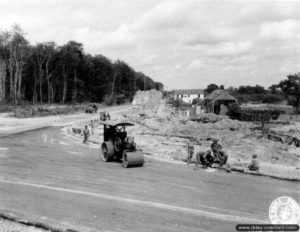Montfiquet (Calvados)
The cities of Normandy during the 1944 battles

- Liberation: 10 June 1944
- Deployed units:
![]() 9th Infantry Regiment, 2nd Infantry Division
9th Infantry Regiment, 2nd Infantry Division
![]() 15th Canadian Forestry Company, Canadian Forestry Corps
15th Canadian Forestry Company, Canadian Forestry Corps
![]() 352. Infanterie-Division
352. Infanterie-Division
- History:
The village of Montfiquet is bordered to the north by the Balleroy forest, also known as the Cerisy forest, most of which lies within its administrative boundaries. According to the initial plans for Operation Overlord, the 5th American Corps was to have seized the village and its forest five days after the start of the landings. The forest was of major tactical importance to the Allies: from its heights, observation of enemy movements to the south was key to securing the bridgehead. It was also crossed by the Bayeux-Saint-Lô road and, at this time of year, the forest provided ample cover for troop concentrations, which could hide from aerial observation.
On 7 June 1944, as a preventive measure and in preparation for the ground offensives of the 5th American Corps, the 9th US Air Force concentrated its efforts in the Aure valley region and above the forest in particular: 467 aircraft flew a total of 35 missions, dropping 500-kilogram bombs. This did not prevent the Germans of the 352nd Infantry Division from continuing to gather forces in this sector, in anticipation of a possible counter-attack.
According to the plans drawn up by the Americans in the late afternoon of 8 June, the 1st Infantry Division was to move around the forest to the east, reaching Balleroy, from midday on 9 June. In a second phase, the division was to link up to the south of the forest with the 2nd Infantry Division, which was to surround the forest from the west, taking Cerisy-la-Forêt. At the centre of the operation, the 9th Infantry Regiment (IR) of the 2nd Infantry Division was tasked with reconnoitring the routes through the forest to the outskirts of Montfiquet.
Despite the terrible human and material cost of the Omaha Beach landings, the Americans began to advance according to plan, but German resistance immediately caused major delays. On 10 June, supported by powerful artillery, Colonel Chester J. Hirschfelder’s 9th Infantry Regiment succeeded in breaking through the enemy defences and pushed deep south through the long straights that cut through the forest. They reached the village of Montfiquet in the evening, which was not held by the Germans, and settled in the area for the night. Six Americans were wounded as they crossed the forest, which, to their great surprise, was virtually undefended.
On 11 June, the men of the 9th IR held the sector pending the alignment of the 2nd Infantry Division to the west and the 1st Infantry Division to the east. On 13 June, Colonel Hirschfelder had to restart the advance southwards.
For the rest of the Battle of Normandy, the forest of Balleroy was used by the Allies for both ammunition dumps and timber. The 15th Canadian Forestry Company, part of the Canadian Forestry Corps, set up in the Montfiquet sector and helped to supply wood for the buildings, tools, protective equipment and other structures needed in the aftermath of the fighting.
Montfiquet map:
